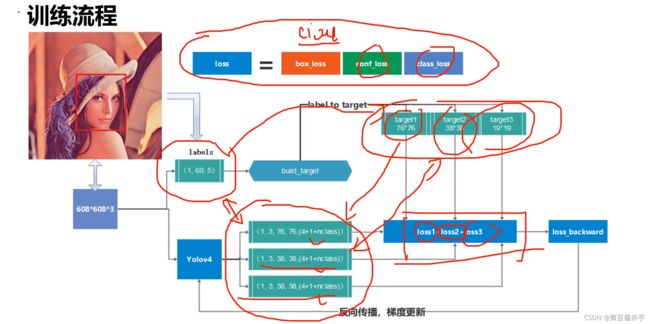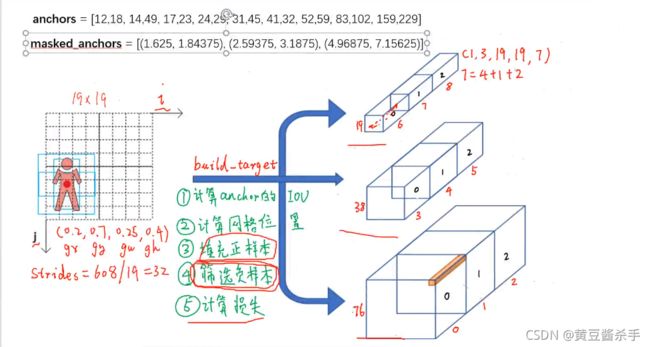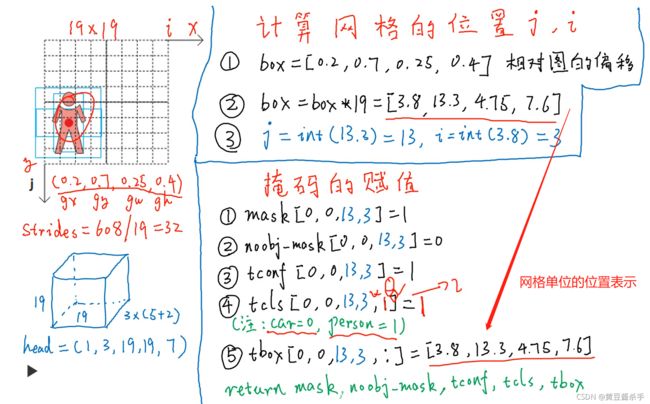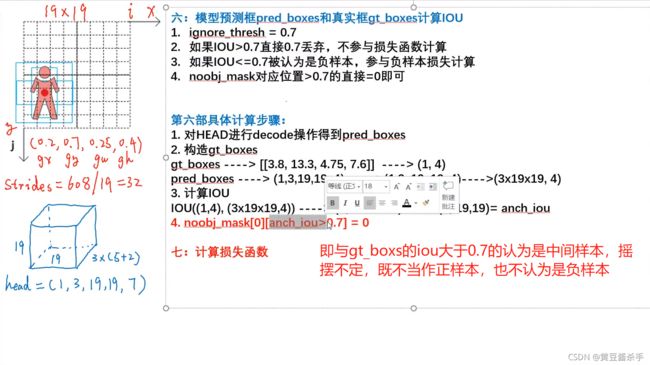YOLOV4-模型训练和代码-pytorch
训练超参
build target
损失函数
位置回归损失,物体自信度损失(正样本和负样本),类别交叉熵损失
import cv2
from random import shuffle
import numpy as np
import torch
import torch.nn as nn
import math
import torch.nn.functional as F
from matplotlib.colors import rgb_to_hsv, hsv_to_rgb
from PIL import Image
from utils.utils import bbox_iou, merge_bboxes
def iou(_box_a, _box_b):
b1_x1, b1_x2 = _box_a[:, 0] - _box_a[:, 2] / 2, _box_a[:, 0] + _box_a[:, 2] / 2
b1_y1, b1_y2 = _box_a[:, 1] - _box_a[:, 3] / 2, _box_a[:, 1] + _box_a[:, 3] / 2
b2_x1, b2_x2 = _box_b[:, 0] - _box_b[:, 2] / 2, _box_b[:, 0] + _box_b[:, 2] / 2
b2_y1, b2_y2 = _box_b[:, 1] - _box_b[:, 3] / 2, _box_b[:, 1] + _box_b[:, 3] / 2
box_a = torch.zeros_like(_box_a)
box_b = torch.zeros_like(_box_b)
box_a[:, 0], box_a[:, 1], box_a[:, 2], box_a[:, 3] = b1_x1, b1_y1, b1_x2, b1_y2
box_b[:, 0], box_b[:, 1], box_b[:, 2], box_b[:, 3] = b2_x1, b2_y1, b2_x2, b2_y2
A = box_a.size(0)
B = box_b.size(0)
max_xy = torch.min(box_a[:, 2:].unsqueeze(1).expand(A, B, 2),
box_b[:, 2:].unsqueeze(0).expand(A, B, 2))
min_xy = torch.max(box_a[:, :2].unsqueeze(1).expand(A, B, 2),
box_b[:, :2].unsqueeze(0).expand(A, B, 2))
inter = torch.clamp((max_xy - min_xy), min=0)
inter = inter[:, :, 0] * inter[:, :, 1]
# 计算先验框和真实框各自的面积
area_a = ((box_a[:, 2]-box_a[:, 0]) *
(box_a[:, 3]-box_a[:, 1])).unsqueeze(1).expand_as(inter) # [A,B]
area_b = ((box_b[:, 2]-box_b[:, 0]) *
(box_b[:, 3]-box_b[:, 1])).unsqueeze(0).expand_as(inter) # [A,B]
# 求IOU
union = area_a + area_b - inter
return inter / union # [A,B]
#---------------------------------------------------#
# 平滑标签
#---------------------------------------------------#
def smooth_labels(y_true, label_smoothing,num_classes):
return y_true * (1.0 - label_smoothing) + label_smoothing / num_classes
def box_ciou(b1, b2):
"""
输入为:
----------
b1: tensor, shape=(batch, feat_w, feat_h, anchor_num, 4), xywh
b2: tensor, shape=(batch, feat_w, feat_h, anchor_num, 4), xywh
返回为:
-------
ciou: tensor, shape=(batch, feat_w, feat_h, anchor_num, 1)
"""
# 求出预测框左上角右下角
b1_xy = b1[..., :2]
b1_wh = b1[..., 2:4]
b1_wh_half = b1_wh/2.
b1_mins = b1_xy - b1_wh_half
b1_maxes = b1_xy + b1_wh_half
# 求出真实框左上角右下角
b2_xy = b2[..., :2]
b2_wh = b2[..., 2:4]
b2_wh_half = b2_wh/2.
b2_mins = b2_xy - b2_wh_half
b2_maxes = b2_xy + b2_wh_half
# 求真实框和预测框所有的iou
intersect_mins = torch.max(b1_mins, b2_mins)
intersect_maxes = torch.min(b1_maxes, b2_maxes)
intersect_wh = torch.max(intersect_maxes - intersect_mins, torch.zeros_like(intersect_maxes))
intersect_area = intersect_wh[..., 0] * intersect_wh[..., 1]
b1_area = b1_wh[..., 0] * b1_wh[..., 1]
b2_area = b2_wh[..., 0] * b2_wh[..., 1]
union_area = b1_area + b2_area - intersect_area
iou = intersect_area / torch.clamp(union_area,min = 1e-6)
# 计算中心的差距
center_distance = torch.sum(torch.pow((b1_xy - b2_xy), 2), axis=-1)
# 找到包裹两个框的最小框的左上角和右下角
enclose_mins = torch.min(b1_mins, b2_mins)
enclose_maxes = torch.max(b1_maxes, b2_maxes)
enclose_wh = torch.max(enclose_maxes - enclose_mins, torch.zeros_like(intersect_maxes))
# 计算对角线距离
enclose_diagonal = torch.sum(torch.pow(enclose_wh,2), axis=-1)
ciou = iou - 1.0 * (center_distance) / torch.clamp(enclose_diagonal,min = 1e-6)
v = (4 / (math.pi ** 2)) * torch.pow((torch.atan(b1_wh[..., 0]/torch.clamp(b1_wh[..., 1],min = 1e-6)) - torch.atan(b2_wh[..., 0]/torch.clamp(b2_wh[..., 1],min = 1e-6))), 2)
alpha = v / torch.clamp((1.0 - iou + v),min=1e-6)
ciou = ciou - alpha * v
return ciou
def clip_by_tensor(t,t_min,t_max):
t=t.float()
result = (t >= t_min).float() * t + (t < t_min).float() * t_min
result = (result <= t_max).float() * result + (result > t_max).float() * t_max
return result
def MSELoss(pred,target):
return (pred-target)**2
def BCELoss(pred,target):
epsilon = 1e-7
pred = clip_by_tensor(pred, epsilon, 1.0 - epsilon)
output = -target * torch.log(pred) - (1.0 - target) * torch.log(1.0 - pred)
return output
class YOLOLoss(nn.Module):
def __init__(self, anchors, num_classes, img_size, label_smooth=0, cuda=True):
super(YOLOLoss, self).__init__()
self.anchors = anchors
self.num_anchors = len(anchors)
self.num_classes = num_classes
self.bbox_attrs = 5 + num_classes
self.img_size = img_size
self.feature_length = [img_size[0]//8,img_size[0]//16,img_size[0]//32]
self.label_smooth = label_smooth
self.ignore_threshold = 0.7
self.lambda_conf = 1.0
self.lambda_cls = 1.0
self.lambda_loc = 1.0
self.cuda = cuda
def forward(self, input, targets=None):
# input为bs,3*(5+num_classes),13,13
# 一共多少张图片
bs = input.size(0)
# 特征层的高
in_h = input.size(2)
# 特征层的宽
in_w = input.size(3)
# 计算步长
# 每一个特征点对应原来的图片上多少个像素点
# 如果特征层为13x13的话,一个特征点就对应原来的图片上的32个像素点
stride_h = self.img_size[1] / in_h
stride_w = self.img_size[0] / in_w
# 把先验框的尺寸调整成特征层大小的形式
# 计算出先验框在特征层上对应的宽高
scaled_anchors = [(a_w / stride_w, a_h / stride_h) for a_w, a_h in self.anchors]
# bs,3*(5+num_classes),13,13 -> bs,3,13,13,(5+num_classes)
prediction = input.view(bs, int(self.num_anchors/3),
self.bbox_attrs, in_h, in_w).permute(0, 1, 3, 4, 2).contiguous()
# 对prediction预测进行调整
conf = torch.sigmoid(prediction[..., 4]) # Conf
pred_cls = torch.sigmoid(prediction[..., 5:]) # Cls pred.
# 找到哪些先验框内部包含物体
mask, noobj_mask, t_box, tconf, tcls, box_loss_scale_x, box_loss_scale_y = self.get_target(targets, scaled_anchors,in_w, in_h,self.ignore_threshold)
noobj_mask, pred_boxes_for_ciou = self.get_ignore(prediction, targets, scaled_anchors, in_w, in_h, noobj_mask)
if self.cuda:
mask, noobj_mask = mask.cuda(), noobj_mask.cuda()
box_loss_scale_x, box_loss_scale_y= box_loss_scale_x.cuda(), box_loss_scale_y.cuda()
tconf, tcls = tconf.cuda(), tcls.cuda()
pred_boxes_for_ciou = pred_boxes_for_ciou.cuda()
t_box = t_box.cuda()
box_loss_scale = 2-box_loss_scale_x*box_loss_scale_y
# losses.
ciou = box_ciou( pred_boxes_for_ciou[mask.bool()], t_box[mask.bool()])
loss_ciou = 1 - ciou
loss_ciou = loss_ciou * box_loss_scale[mask.bool()]
# ciou = (1 - box_ciou( pred_boxes_for_ciou[mask.bool()], t_box[mask.bool()]))* box_loss_scale[mask.bool()]
loss_loc = torch.sum(loss_ciou / bs)
loss_conf = torch.sum(BCELoss(conf, mask) * mask / bs) + \
torch.sum(BCELoss(conf, mask) * noobj_mask / bs)
# print(smooth_labels(tcls[mask == 1],self.label_smooth,self.num_classes))
loss_cls = torch.sum(BCELoss(pred_cls[mask == 1], smooth_labels(tcls[mask == 1],self.label_smooth,self.num_classes))/bs)
# print(loss_loc,loss_conf,loss_cls)
loss = loss_conf * self.lambda_conf + loss_cls * self.lambda_cls + loss_loc * self.lambda_loc
return loss, loss_conf.item(), loss_cls.item(), loss_loc.item()
def get_target(self, target, anchors, in_w, in_h, ignore_threshold):
# 计算一共有多少张图片
bs = len(target)
# 获得先验框
anchor_index = [[0,1,2],[3,4,5],[6,7,8]][self.feature_length.index(in_w)]
subtract_index = [0,3,6][self.feature_length.index(in_w)]
# 创建全是0或者全是1的阵列
mask = torch.zeros(bs, int(self.num_anchors/3), in_h, in_w, requires_grad=False)
noobj_mask = torch.ones(bs, int(self.num_anchors/3), in_h, in_w, requires_grad=False)
tx = torch.zeros(bs, int(self.num_anchors/3), in_h, in_w, requires_grad=False)
ty = torch.zeros(bs, int(self.num_anchors/3), in_h, in_w, requires_grad=False)
tw = torch.zeros(bs, int(self.num_anchors/3), in_h, in_w, requires_grad=False)
th = torch.zeros(bs, int(self.num_anchors/3), in_h, in_w, requires_grad=False)
t_box = torch.zeros(bs, int(self.num_anchors/3), in_h, in_w, 4, requires_grad=False)
tconf = torch.zeros(bs, int(self.num_anchors/3), in_h, in_w, requires_grad=False)
tcls = torch.zeros(bs, int(self.num_anchors/3), in_h, in_w, self.num_classes, requires_grad=False)
box_loss_scale_x = torch.zeros(bs, int(self.num_anchors/3), in_h, in_w, requires_grad=False)
box_loss_scale_y = torch.zeros(bs, int(self.num_anchors/3), in_h, in_w, requires_grad=False)
for b in range(bs):
for t in range(target[b].shape[0]):
# 计算出在特征层上的点位
gx = target[b][t, 0] * in_w
gy = target[b][t, 1] * in_h
gw = target[b][t, 2] * in_w
gh = target[b][t, 3] * in_h
# 计算出属于哪个网格
gi = int(gx)
gj = int(gy)
# 计算真实框的位置
gt_box = torch.FloatTensor(np.array([0, 0, gw, gh])).unsqueeze(0)
# 计算出所有先验框的位置
anchor_shapes = torch.FloatTensor(np.concatenate((np.zeros((self.num_anchors, 2)),
np.array(anchors)), 1))
# 计算重合程度
anch_ious = bbox_iou(gt_box, anchor_shapes)
# Find the best matching anchor box
best_n = np.argmax(anch_ious)
if best_n not in anchor_index:
continue
# Masks
if (gj < in_h) and (gi < in_w):
best_n = best_n - subtract_index
# 判定哪些先验框内部真实的存在物体
noobj_mask[b, best_n, gj, gi] = 0
mask[b, best_n, gj, gi] = 1
# 计算先验框中心调整参数
tx[b, best_n, gj, gi] = gx
ty[b, best_n, gj, gi] = gy
# 计算先验框宽高调整参数
tw[b, best_n, gj, gi] = gw
th[b, best_n, gj, gi] = gh
# 用于获得xywh的比例
box_loss_scale_x[b, best_n, gj, gi] = target[b][t, 2]
box_loss_scale_y[b, best_n, gj, gi] = target[b][t, 3]
# 物体置信度
tconf[b, best_n, gj, gi] = 1
# 种类
tcls[b, best_n, gj, gi, int(target[b][t, 4])] = 1
else:
print('Step {0} out of bound'.format(b))
print('gj: {0}, height: {1} | gi: {2}, width: {3}'.format(gj, in_h, gi, in_w))
continue
t_box[...,0] = tx
t_box[...,1] = ty
t_box[...,2] = tw
t_box[...,3] = th
return mask, noobj_mask, t_box, tconf, tcls, box_loss_scale_x, box_loss_scale_y
def get_ignore(self,prediction,target,scaled_anchors,in_w, in_h,noobj_mask):
bs = len(target)
anchor_index = [[0,1,2],[3,4,5],[6,7,8]][self.feature_length.index(in_w)]
scaled_anchors = np.array(scaled_anchors)[anchor_index]
# 先验框的中心位置的调整参数
x = torch.sigmoid(prediction[..., 0])
y = torch.sigmoid(prediction[..., 1])
# 先验框的宽高调整参数
w = prediction[..., 2] # Width
h = prediction[..., 3] # Height
FloatTensor = torch.cuda.FloatTensor if x.is_cuda else torch.FloatTensor
LongTensor = torch.cuda.LongTensor if x.is_cuda else torch.LongTensor
# 生成网格,先验框中心,网格左上角
grid_x = torch.linspace(0, in_w - 1, in_w).repeat(in_w, 1).repeat(
int(bs*self.num_anchors/3), 1, 1).view(x.shape).type(FloatTensor)
grid_y = torch.linspace(0, in_h - 1, in_h).repeat(in_h, 1).t().repeat(
int(bs*self.num_anchors/3), 1, 1).view(y.shape).type(FloatTensor)
# 生成先验框的宽高
anchor_w = FloatTensor(scaled_anchors).index_select(1, LongTensor([0]))
anchor_h = FloatTensor(scaled_anchors).index_select(1, LongTensor([1]))
anchor_w = anchor_w.repeat(bs, 1).repeat(1, 1, in_h * in_w).view(w.shape)
anchor_h = anchor_h.repeat(bs, 1).repeat(1, 1, in_h * in_w).view(h.shape)
# 计算调整后的先验框中心与宽高
pred_boxes = FloatTensor(prediction[..., :4].shape)
pred_boxes[..., 0] = x + grid_x
pred_boxes[..., 1] = y + grid_y
pred_boxes[..., 2] = torch.exp(w) * anchor_w
pred_boxes[..., 3] = torch.exp(h) * anchor_h
for i in range(bs):
pred_boxes_for_ignore = pred_boxes[i]
pred_boxes_for_ignore = pred_boxes_for_ignore.view(-1, 4)
if len(target[i]) > 0:
gx = target[i][:, 0:1] * in_w
gy = target[i][:, 1:2] * in_h
gw = target[i][:, 2:3] * in_w
gh = target[i][:, 3:4] * in_h
gt_box = torch.FloatTensor(np.concatenate([gx, gy, gw, gh],-1)).type(FloatTensor)
anch_ious = iou(gt_box, pred_boxes_for_ignore)
for t in range(target[i].shape[0]):
anch_iou = anch_ious[t].view(pred_boxes[i].size()[:3])
noobj_mask[i][anch_iou>self.ignore_threshold] = 0
return noobj_mask, pred_boxes
训练代码构建
代码讲解和实现
import os
import sys
sys.path.append(r'D:\ubuntu_share\yolov4-pytorch1')
import numpy as np
import time
import torch
from torch.autograd import Variable
import torch.nn as nn
import torch.optim as optim
import torch.nn.functional as F
import torch.backends.cudnn as cudnn
from torch.utils.data import DataLoader
from utils.dataloader import train_dataset_collate, test_dataset_collate, TrainDataset, TestDataset
from utils.generator import TrainGenerator, TestGenerator
from yolo_loss import YOLOLoss
from yolo_layer import YoloLayer
from tqdm import tqdm
from darknet.darknet import *
from easydict import EasyDict
from config import Cfg
from Evaluation.map_eval_pil import compute_map
from tensorboardX import SummaryWriter
from utils.utils import *
Cfg.darknet_cfg = 'work_dir/yolo4_train.cfg'
Cfg.train_data = 'work_dir/my_train1.txt'
Cfg.anchors_path = 'work_dir/yolo_anchors.txt'
Cfg.classes_path = 'work_dir/my_classes.txt'
Cfg.weights_path = 'weights/yolov4.weights'
#Cfg.pth_path = 'pth/yolo4_weights_my.pth'
Cfg.pth_path = 'chk_dark/Epoch_050_Loss_7.7722.pth'
Cfg.check = 'chk_dark'
Cfg.use_data_loader = True
Cfg.first_train = False
Cfg.cur_epoch = 0
Cfg.total_epoch = 80
Cfg.freeze_mode = False
#valid
Cfg.valid_mode = False
Cfg.confidence = 0.3
Cfg.nms_thresh = 0.4
Cfg.draw_box = True
Cfg.save_error_miss = False
Cfg.input_dir = r'D:\ubuntu_share\yolov4-pytorch\object-detection-crowdai'
Cfg.save_err_mis = True
#调用Evaluation模块, 进行map计算和类别准召率计算
def make_labels_and_compute_map(infos, classes, input_dir, save_err_miss=False):
out_lines,gt_lines = [],[]
out_path = 'Evaluation/out.txt'
gt_path = 'Evaluation/true.txt'
foutw = open(out_path, 'w')
fgtw = open(gt_path, 'w')
for info in infos:
out, gt, shapes = info
for i, images in enumerate(out):
for box in images:
bbx = [box[0]*shapes[i][1], box[1]*shapes[i][0], box[2]*shapes[i][1], box[3]*shapes[i][0]]
bbx = str(bbx)
cls = classes[int(box[6])]
prob = str(box[4])
img_name = os.path.split(shapes[i][2])[-1]
line = '\t'.join([img_name, 'Out:', cls, prob, bbx])+'\n'
out_lines.append(line)
for i, images in enumerate(gt):
for box in images:
bbx = str(box.tolist()[0:4])
cls = classes[int(box[4])]
img_name = os.path.split(shapes[i][2])[-1]
line = '\t'.join([img_name, 'Out:', cls, '1.0', bbx])+'\n'
gt_lines.append(line)
foutw.writelines(out_lines)
fgtw.writelines(gt_lines)
foutw.close()
fgtw.close()
args = EasyDict()
args.annotation_file = 'Evaluation/true.txt'
args.detection_file = 'Evaluation/out.txt'
args.detect_subclass = False
args.confidence = 0.2
args.iou = 0.3
args.record_mistake = True
args.draw_full_img = save_err_miss
args.draw_cut_box = False
args.input_dir = input_dir
args.out_dir = 'out_dir'
Map = compute_map(args)
return Map
# ---------------------------------------------------#
# 获得类和先验框
# ---------------------------------------------------#
def get_classes(classes_path):
'''loads the classes'''
with open(classes_path) as f:
class_names = f.readlines()
class_names = [c.strip() for c in class_names]
return class_names
def get_anchors(anchors_path):
'''loads the anchors from a file'''
with open(anchors_path) as f:
anchors = f.readline()
anchors = [float(x) for x in anchors.split(',')]
return np.array(anchors).reshape([-1, 3, 2])
# return np.array(anchors).reshape([-1, 3, 2])[::-1, :, :]
def get_lr(optimizer):
for param_group in optimizer.param_groups:
return param_group['lr']
def gen_lr_scheduler(lr, cur_epoch, model):
init_lr = lr*pow(0.9, cur_epoch)
print('init learning rate:', init_lr)
optimizer = optim.Adam(model.parameters(), init_lr, weight_decay=5e-4)
if Cfg.cosine_lr:
lr_scheduler = optim.lr_scheduler.CosineAnnealingLR(optimizer, T_max=5, eta_min=1e-5)
else:
lr_scheduler = optim.lr_scheduler.StepLR(optimizer, step_size=1, gamma=0.9)
return lr_scheduler,optimizer
def gen_burnin_lr_scheduler(lr, cur_batch, model):
# learning rate setup
def burnin_schedule(i):
i = i+1
if i < Cfg.burn_in:
factor = pow(i / Cfg.burn_in, 4)
elif i < Cfg.steps[0]:
factor = 1.0
elif i < Cfg.steps[1]:
factor = 0.1
else:
factor = 0.01
return factor
if Cfg.TRAIN_OPTIMIZER == 'adam':
optimizer = optim.Adam(
[{'params': model.parameters(), 'initial_lr': lr}],
lr=lr,
betas=(0.9, 0.999),
eps=1e-08,
)
elif Cfg.TRAIN_OPTIMIZER == 'sgd':
optimizer = optim.SGD(
[{'params': model.parameters(), 'initial_lr': lr}],
lr=lr,
momentum=Cfg.momentum,
weight_decay=Cfg.decay,
)
else:
print('optimizer must be adam or sgd...')
return None,None
scheduler = optim.lr_scheduler.LambdaLR(optimizer, burnin_schedule, last_epoch=cur_batch-1)
print('update learning rate:', scheduler.get_last_lr()[0])
return scheduler, optimizer
def get_train_lines(train_data):
# 0.1用于验证,0.9用于训练
val_split = 0.1
with open(train_data) as f:
lines = f.readlines()
np.random.seed(10101)
np.random.shuffle(lines)
np.random.seed(None)
num_val = int(len(lines) * val_split)
num_train = len(lines) - num_val
return lines, num_train, num_val
def freeze_training_dark(model, flag=False, layers=137):
for name, param in model.named_parameters():
if int(name.split('.')[1]) <= layers:
print(int(name.split('.')[1]))
param.requires_grad = flag
def print_model(model):
model_dict = model.state_dict() # 会返回网络结构参数的名称,作为字典键值,参数权重作为值
for key in model_dict:
print('model items:', key, '---->', np.shape(model_dict[key]))
def load_model_pth(model, pth):
print('Loading weights into state dict, name: %s'%(pth))
device = torch.device('cuda' if torch.cuda.is_available() else 'cpu')
model_dict = model.state_dict()
pretrained_dict = torch.load(pth, map_location=device)
pretrained_dict = {k: v for k, v in pretrained_dict.items() if np.shape(model_dict[k]) == np.shape(v)}
for key in pretrained_dict:
print('pretrained items:', key)
model_dict.update(pretrained_dict)
model.load_state_dict(model_dict)
print('Finished!')
return model
def get_epoch_by_pth():
try:
pth = Cfg.pth_path
epoch = os.path.split(pth)[-1].split('_')[1]
epoch = int(epoch)
except Exception as e:
print(e, 'start epoch: %d'%Cfg.cur_epoch)
return Cfg.cur_epoch
return epoch
def find_pth_by_epoch(epoch, path):
pth_list = os.listdir(path)
for name in pth_list:
curpo = name.split('_')[1]
if curpo == '%03d'%(epoch):
return os.path.join(path, name)
return ''
def valid(epoch_lis, classes, draw=True, cuda=True, anchors=[]):
writer = SummaryWriter(log_dir='valid_logs',flush_secs=60)
epoch_size_val = num_val // gpu_batch
model = Darknet(Darknet_Cfg)
anchor_masks = [[0, 1, 2], [3, 4, 5], [6, 7, 8]]
yolo_decodes = []
anchors = anchors.reshape([-1])
for i in range(3):
head = YoloLayer((Cfg.width, Cfg.height), anchor_masks, len(classes),
anchors, anchors.shape[0] // 2).eval()
yolo_decodes.append(head)
if Use_Data_Loader:
val_dataset = TestDataset(lines[num_train:], (input_shape[0], input_shape[1]))
gen_val = DataLoader(val_dataset, batch_size=gpu_batch, num_workers=8, pin_memory=True,
drop_last=True, collate_fn=test_dataset_collate)
else:
gen_val = TestGenerator(gpu_batch, lines[num_train:],
(input_shape[0], input_shape[1])).generate()
for epo in epoch_lis:
pth_path = find_pth_by_epoch(epo, Cfg.check)
if not pth_path:
print('pth_path is error...')
return False
model = load_model_pth(model, pth_path)
cudnn.benchmark = True
model = model.cuda()
model.eval() # 将模型设置为验证模式,就不会计算梯度,节省显存
with tqdm(total=epoch_size_val, mininterval=0.3) as pbar:
infos = []
for i, batch in enumerate(gen_val):
images_src, images, targets, shapes = batch[0], batch[1], batch[2], batch[3]
with torch.no_grad():
if cuda:
images_val = Variable(torch.from_numpy(images).type(torch.FloatTensor)).cuda()
else:
images_val = Variable(torch.from_numpy(images).type(torch.FloatTensor))
outputs = model(images_val)
output_list = []
for i in range(3):
output_list.append(yolo_decodes[i](outputs[i]))
output = torch.cat(output_list, 1)
batch_detections = non_max_suppression(output, len(classes),
conf_thres=Cfg.confidence,
nms_thres=Cfg.nms_thresh)
#print(batch_detections)
boxs = [box.cpu().numpy() for box in batch_detections if box != None]
#boxs = utils.post_processing(images_val, Cfg.confidence, Cfg.nms_thresh, outputs)
infos.append([boxs, targets, shapes])
if draw:
for x in range(len(boxs)):
os.makedirs('result_%d'%epo, exist_ok=True)
savename = os.path.join('result_%d'%epo, os.path.split(shapes[x][2])[-1])
plot_boxes_cv2(images_src[x], boxs[x], savename=savename, class_names=class_names)
pbar.update(1)
print()
print('===========================================================================================================')
print('++++++++cur valid epoch %d, pth_name: %s++++++++'%(epo, pth_path))
Map = make_labels_and_compute_map(infos, classes, Cfg.input_dir, save_err_miss=Cfg.save_err_mis)
writer.add_scalar('MAP/epoch', Map, epo)
print()
return True
def train(cur_epoch, Epoch, cuda=True, anchors=[]):
#使用tensorboardX来可视化训练指标
writer = SummaryWriter(log_dir='train_logs',flush_secs=60)
model = Darknet(Darknet_Cfg)
model.print_network() # 打印网络结构,同样可以采用model.print_model()
#第一次训练直接导入darknet的权重
#中间训练导入check_point里的权重
#cut:
# 默认: 137, 推荐104(only backbone), 116(backbone+SPP), 126(backbone+SPP+1_concat)
# cut必须 < 138,因为138刚好是76的1X1卷积头部,不同类别数的检测任务,1X1预测卷积的权重参数是不一样的
if Cfg.first_train:
model.load_weights(weights_path, pretrained=True, cut=116)
else:
model = load_model_pth(model, pth_path)
cudnn.benchmark = True
model = model.cuda()
# 建立loss函数
yolo_losses = []
for i in range(3):
yolo_losses.append(YOLOLoss(np.reshape(anchors, [-1, 2]), num_classes,
(input_shape[1], input_shape[0]), smoooth_label)) # 每三个头计算LOSS的时候就会调用前向传播
#lr_scheduler, optimizer = gen_lr_scheduler(lr, cur_epoch, model)
#使用darknet框架里的burn_in训练方法,调整学习率
lr_scheduler, optimizer = gen_burnin_lr_scheduler(lr, cur_batch, model)
# if Cfg.freeze_mode:
# freeze_training_dark(model, flag=False, layers=137)
# else:
# freeze_training_dark(model, flag=True, layers=137)
if Use_Data_Loader:
train_dataset = TrainDataset(lines[:num_train], (input_shape[0], input_shape[1]), mosaic=mosaic) # 检查batch中的图像是不是会出错,如果出错的话定位到出错图像
gen = DataLoader(train_dataset, batch_size=gpu_batch, num_workers=8, pin_memory=True,
drop_last=True, collate_fn=train_dataset_collate) # 在这里进行了数据增强
else:
gen = TrainGenerator(gpu_batch, lines[:num_train],
(input_shape[0], input_shape[1])).generate(mosaic=mosaic) # 检查batch中的图像是不是会出错,如果出错的话定位到出错图像
epoch_size = max(1, num_train // gpu_batch)
for epoch in range(cur_epoch, Epoch):
total_loss = 0
cur_step = 0
with tqdm(total=epoch_size, desc=f'Epoch {epoch + 1}/{Epoch}', postfix=dict, mininterval=0.3) as pbar:
model.train()
start_time = time.time()
for iteration, batch in enumerate(gen):
if iteration >= epoch_size:
break
images, targets = batch[0], batch[1]
with torch.no_grad():
if cuda:
images = Variable(torch.from_numpy(images).type(torch.FloatTensor)).cuda()
targets = [Variable(torch.from_numpy(ann).type(torch.FloatTensor)) for ann in targets]
else:
images = Variable(torch.from_numpy(images).type(torch.FloatTensor))
targets = [Variable(torch.from_numpy(ann).type(torch.FloatTensor)) for ann in targets]
outputs = model(images)
losses = []
losses_loc = []
losses_conf = []
losses_cls = []
for i in range(3):
loss_item = yolo_losses[i](outputs[i], targets)
losses.append(loss_item[0])
losses_loc.append(loss_item[3])
losses_conf.append(loss_item[1])
losses_cls.append(loss_item[2])
loss = sum(losses) / Cfg.subdivisions
loss_loc = sum(losses_loc)
loss_conf = sum(losses_conf)
loss_cls = sum(losses_cls)
loss.backward()
waste_time = time.time() - start_time
total_loss += loss
cur_step += 1
#将第五个Epoch开始写入到tensorboard,每一步都写
if epoch > 2:
writer.add_scalar('total_loss/gpu_batch', loss*Cfg.subdivisions, (epoch * epoch_size + iteration))
writer.add_scalar('loss_loc/gpu_batch', loss_loc, (epoch * epoch_size + iteration))
writer.add_scalar('loss_conf/gpu_batch', loss_conf, (epoch * epoch_size + iteration))
writer.add_scalar('loss_cls/gpu_batch', loss_cls, (epoch * epoch_size + iteration))
if cur_step % Cfg.subdivisions == 0:
optimizer.step()
if Cfg.burn_in > 0:
lr_scheduler.step()
model.zero_grad()
pbar.set_postfix(**{'loss_cur': loss.item()*Cfg.subdivisions,
'loss_total': total_loss.item() / (iteration + 1)*Cfg.subdivisions,
'lr': get_lr(optimizer),
'step/s': waste_time})
pbar.update(1)
start_time = time.time()
# if Cfg.burn_in == 0:
# lr_scheduler.step()
print('Epoch:' + str(epoch + 1) + '/' + str(Epoch))
print('Total Loss: %.4f || Last Loss: %.4f ' % (total_loss / (epoch_size + 1)*Cfg.subdivisions, loss.item()*Cfg.subdivisions))
print('Saving state, iter:', str(epoch + 1))
torch.save(model.state_dict(), '%s/Epoch_%03d_Loss_%.4f.pth' % (Cfg.check,
(epoch + 1), total_loss / (epoch_size + 1)*Cfg.subdivisions))
if __name__ == "__main__":
# 一般为608
input_shape = (Cfg.h, Cfg.w)
# 是否使用余弦学习率
Cosine_lr = Cfg.cosine_lr
# 是否使用马赛克数据增强
mosaic = Cfg.mosaic
# 用于设定是否使用cuda
Cuda = True
smoooth_label = Cfg.smoooth_label
# -------------------------------#
# Dataloder的使用
# -------------------------------#
Use_Data_Loader = Cfg.use_data_loader
Darknet_Cfg = Cfg.darknet_cfg
train_data = Cfg.train_data
# -------------------------------#
# 获得先验框和类
# -------------------------------#
class_names = get_classes(Cfg.classes_path)
num_classes = len(class_names)
print('classes:', class_names, num_classes)
lr = Cfg.learning_rate
batch_size = Cfg.batch
#是否为首次训练
if Cfg.first_train:
cur_epoch = 0
else:
cur_epoch = get_epoch_by_pth()
total_epoch = Cfg.total_epoch
# 一次送入GPU的数据量
gpu_batch = Cfg.batch // Cfg.subdivisions # gpu_batch=8
lines, num_train, num_val = get_train_lines(train_data)
# 当前的训练batch数,用于调节是否burn_in,以及学习率,恢复训练时会使用到
# 首次训练为0
cur_batch = num_train * cur_epoch // batch_size
# 1.需要生成的先验框尺寸,如果用darknet权重和cfg加载,会使用yolov4.cfg里的anchors
# 2.对于计算训练损失,不论是darknet权重加载还是pth加载,都需要使用这个参数
anchors = get_anchors(Cfg.anchors_path)
weights_path = Cfg.weights_path
pth_path = Cfg.pth_path
if Cfg.valid_mode:
valid([50], classes={0: 'car', 1: 'pedestrian'}, draw=Cfg.draw_box, anchors=anchors)
else:
train(cur_epoch, total_epoch, cuda=True, anchors=anchors)




